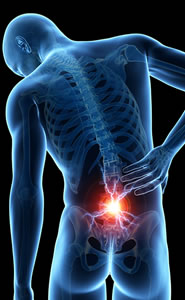About Back Pain
“Great blunders are often made, like large ropes,
through a multitude of fibers.”
-Victor Hugo

The spine is a complicated structure and it invites mistakes in diagnosis and treatment—mistakes that can ruin your life. (See How the Spine Works for a more comprehensive explanation of spinal anatomy.)
Back pain is one of mankind”s most common complaints. In the U.S., short episodes of acute low back pain are the second most common reason for physician visits. Up to 85% of adults experience back pain at some point in their life. Approximately fifty percent of employed adults have at least one episode of back pain annually.
Back pain is classified according to cause. Approximately 85% of back pain patients are diagnosed with nonspecific acute back pain. This type of pain is based on painful or “pulled” muscles or painful facets. (Facets are the joints interconnecting the vertebra, from the top of the neck to where the spine connects to the sacrum.) It has no has no serious underlying structural cause.
However, secondary back pain, due to an underlying condition, accounts for nearly 2% of the cases. The most common underlying cause in these cases is a herniated disc. Ninety five percent of disc herniations occur at the lowest two lumbar levels—L4-5 and L5-S1. (See Discogenic Pain Procedures for a more comprehensive explanation of disc herniation.) Cancer, infections of the vertebra or discs, and epidural space within the spinal canal, account for 1% percent of the patients.
Back pain in workers 40-65 cost employers $7.4 billion annually. Seventy two percent of this cost is due to exacerbations in patients with a history of back pain. Those with a history of episodic worsening of back pain are more likely to persist in this pattern. In the United States, lower back pain is the primary reason for individuals under the age of 45 to alter their lifestyle by reducing activity, fifth most common reason for hospitalization, and the third leading cause for surgery. Up to 30% of patients with acute back pain go on to develop chronic back pain.
Chronic back pain is among the top 10 most expensive conditions in the United States, costing in the $35 billion dollar range annually. Moreover, treatment of chronic back pain is often unsuccessful in giving long-standing relief. Two thirds of patients in pain clinics suffer permanently with failed back surgery syndrome—they have persistent pain following spine surgery. Nationally, two thirds of patients with thoraco-lumbar fusions end up disabled. A much smaller group of patients are disabled because of failed discectomies. Not only is the surgery unsuccessful, but the pain management in those with failed back surgery often fails to liberate patients from the pain clinic system or put them back to work.
As this website repeatedly states, diagnosis is key to appropriate treatment and the correct diagnosis of spinal conditions is often lacking. The complicated anatomy of the spine is part of the problem—which structure is really the cause of pain? Not all structurally abnormal areas of the spine necessarily cause a patient’s complaint. Indeed much spinal pain is due to areas of the spine that appear normal on MRI s and other studies. On the other hand, in cases of structurally based pain, the key is treatment causing the best long term result with the least amount of treatment induced disability.
Can back pain and its associated disability be prevented? The tendency for discs to degenerate, beginning the path down towards chronic back problems, is under genetic influence, and therefore not altered entirely by the most healthy lifestyle. However, obesity, acting irresponsibly as a weekend warrior, losing core strength in a sedentary job, chronic poor posture, overusing the back in frequent hard physical labor, and exposure to bodily trauma can all accelerate your spinal deterioration. So can spinal surgery of any kind—especially thoraco-lumbar fusions. Common sense dictates that spinal deterioration can be reduced with weight control, sensible and regular exercise, periodic change of position and stretching throughout the course of the day, and, if needed, obtaining excellent medical advice in dealing with any serious or persistent spine problem. As in the rest of life, an ounce of prevention…
The above comments notwithswtanding, spinal disorders can be diagnosed and treated appropriately, and with a very good result, keeping you at work and able to enjoy a full social and family life. Find the right physician who has the interest, time, and experience to help you. How this is done and why it is the only solution, as well as why it is increasingly difficult to achieve, is discussed throughout this website.
(See How the Spine Works for a more comprehensive explanation of spinal anatomy.)
Visit us on... ![]()
![]()
Emile M. Hiesiger, M.D.
| The Corinthian |
| 345 East 37th Street |
| Suite 320 |
| New York, NY 10016 |
| • Phone (212) 697-1411 or |
| • Phone (212) 263-6123 |
| • Fax (212) 697-1399 |
Add us to your contacts. Snap below!

*instructions for qrCode use









